Pisa Travel Guide: One-Day Itinerary
Travel Guide
Pisa
Itinerary for One Day in Pisa
Welcome to Pisa, a charming city that will captivate you with its rich history, impressive architecture, and authentic Tuscan atmosphere!
This comprehensive travel guide will lead you through Pisa’s most interesting attractions, offering you an authentic and memorable experience. Get ready to explore vibrant squares, medieval buildings, culinary delights, and stunning landscapes.
The proposed itinerary is based on my personal experience, providing 100% original information and useful recommendations to help you make the most of your stay in Pisa.
A Day in Pisa
- 13:35 – Arrival at Pisa International Airport: We landed at Pisa International Airport and were greeted by the perfect weather at the end of May. We decided to walk to Pisa Central Station to leave our luggage in a locker and explore the city without any burdens.
- Pisa Central Station and Piazza dei Miracoli: After securing our luggage in the station’s locker, we set off for Piazza dei Miracoli, one of the most renowned squares in the world. This UNESCO World Heritage Site is home to some of Italy’s most iconic monuments.
- Leaning Tower of Pisa: The Leaning Tower of Pisa, or Torre Pendente di Pisa, is the freestanding bell tower of the cathedral of Pisa. Known worldwide for its unintended tilt, the tower began to lean during construction in the 12th century due to unstable foundation soil. Over the centuries, efforts have been made to stabilize it, and today, visitors can climb its 294 steps for a breathtaking view of the city.
- Fontana dei Putti: Located near the Leaning Tower, the Fontana dei Putti is a charming fountain adorned with cherubs. It was sculpted by Giovanni Antonio Cybei in the 18th century and adds a delightful touch to the piazza with its playful figures.
- Il Camposanto: The Campo Santo, or Sacred Field, is a monumental cemetery that is said to contain soil brought back from Golgotha during the Crusades. Completed in 1464, the cemetery is a tranquil place with impressive frescoes and Gothic cloisters.
- Stop at Il Gelato di Toto: On our way to the tower, we cooled off with a delicious ice cream from Il Gelato di Toto. A scoop of ice cream cost us 2.5 euros. The shop is renowned for its artisanal gelato, made with fresh, local ingredients, offering a perfect treat to beat the heat.
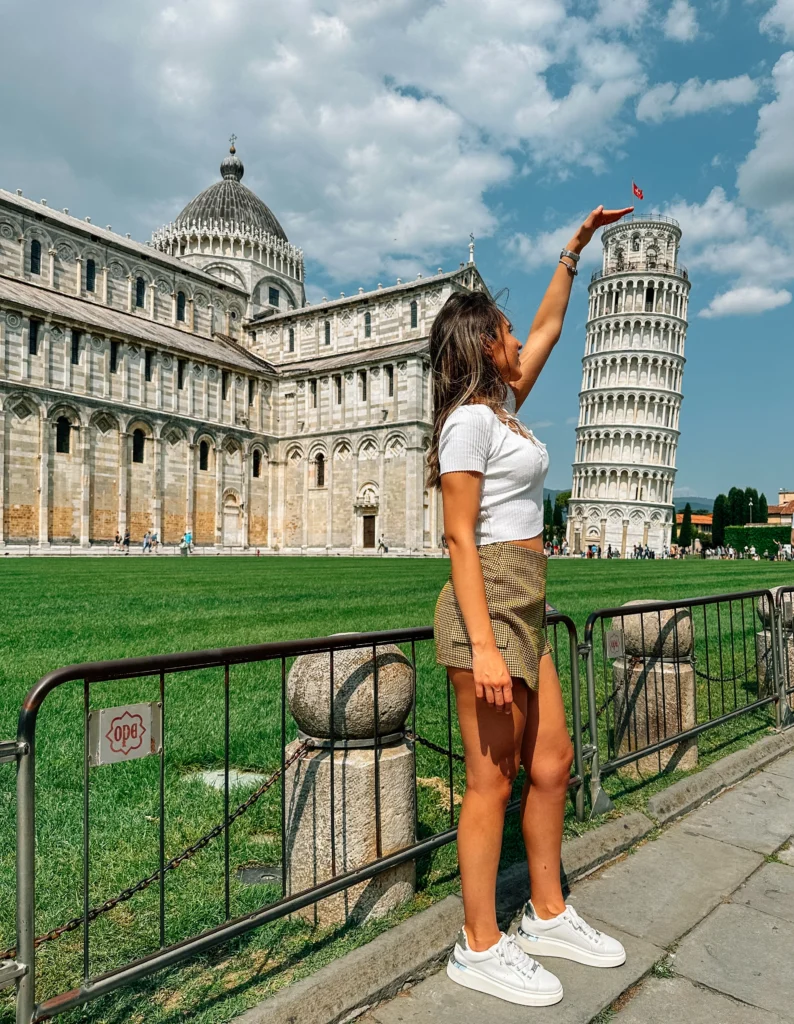
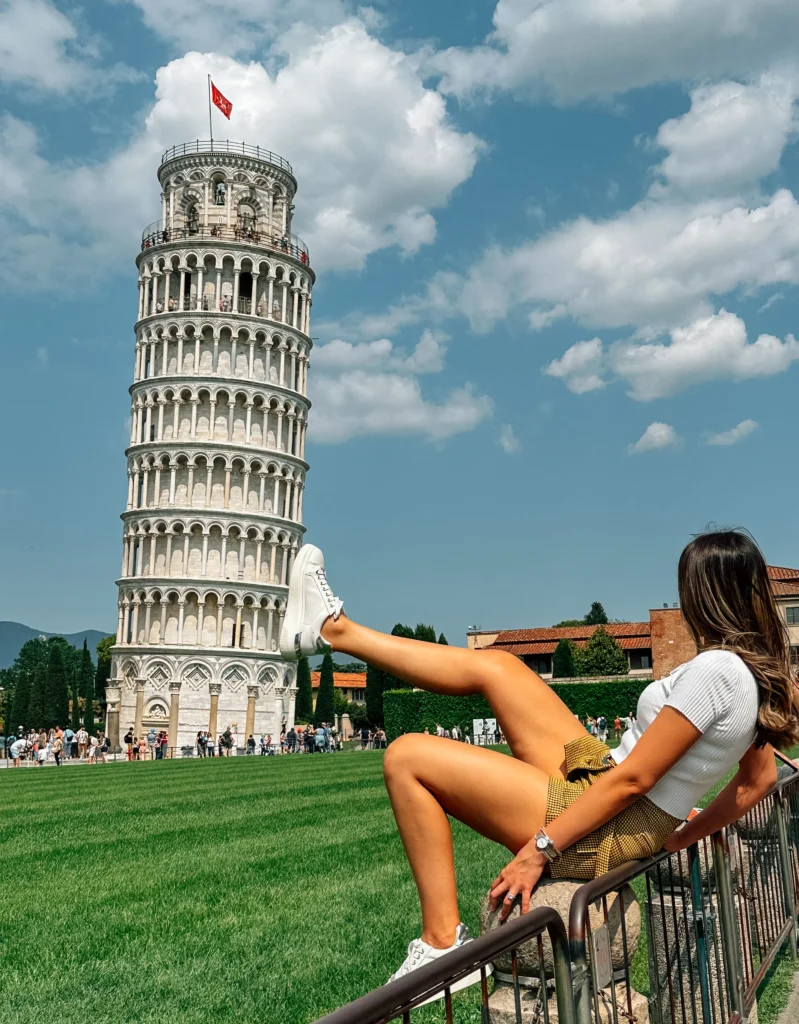
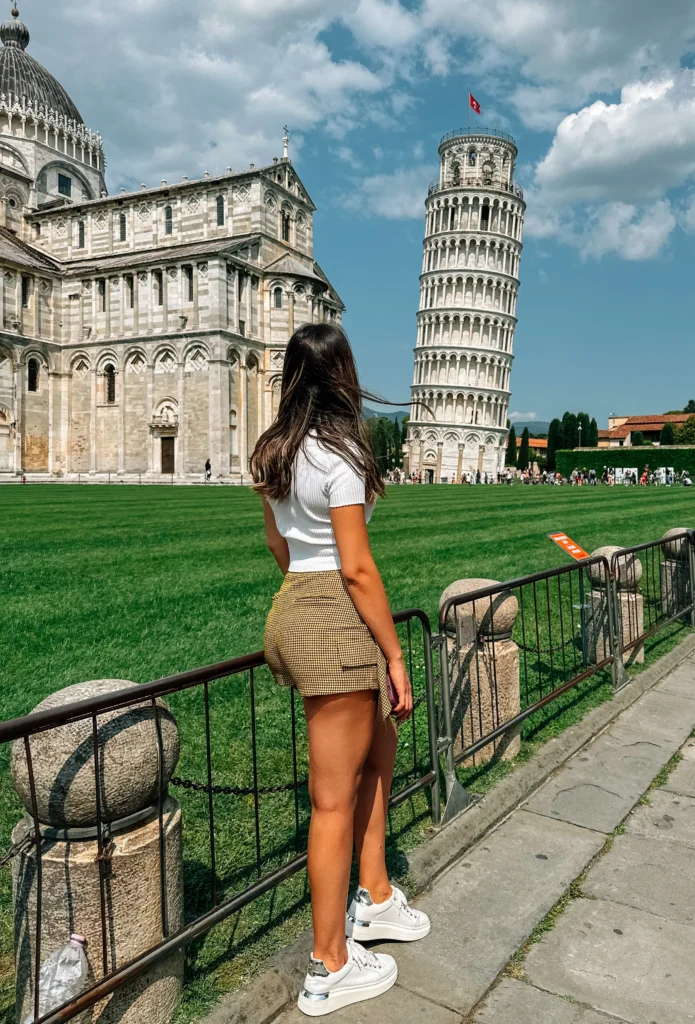
- Il Duomo di Pisa: Also in Piazza dei Miracoli, you can admire the Pisa Cathedral, known as Il Duomo di Pisa. This medieval Roman Catholic cathedral, dedicated to the Assumption of the Virgin Mary, showcases a blend of Romanesque and Gothic architectural styles. Construction began in 1063, and the cathedral’s stunning facade features intricate marble work and beautiful bronze doors.
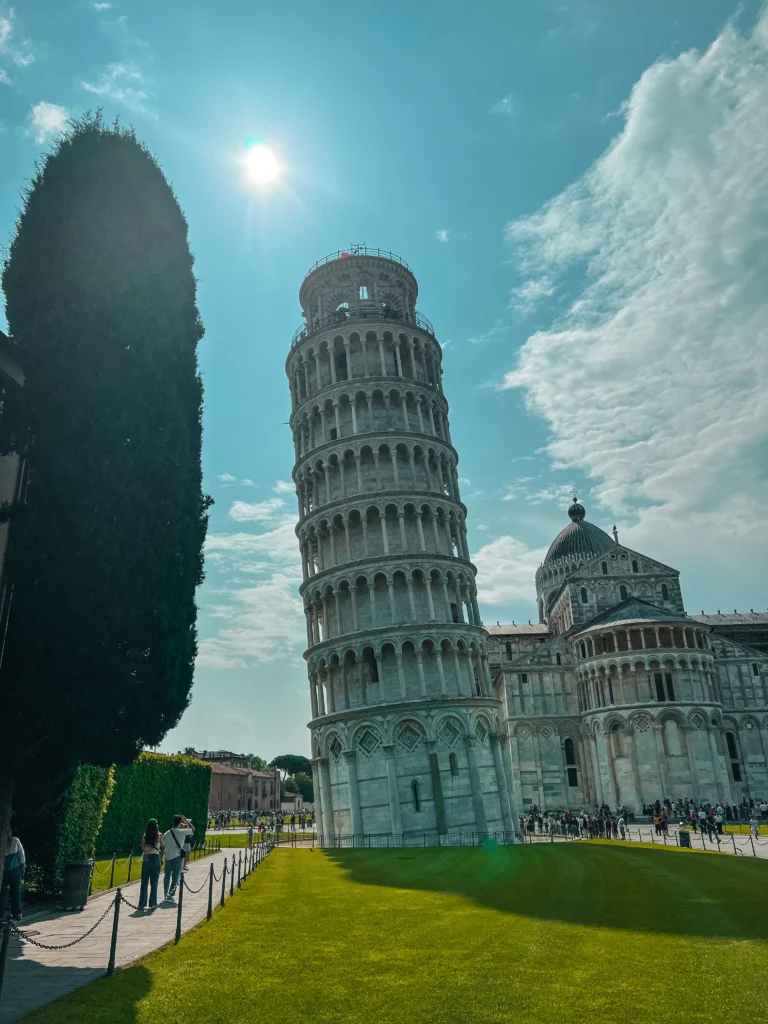

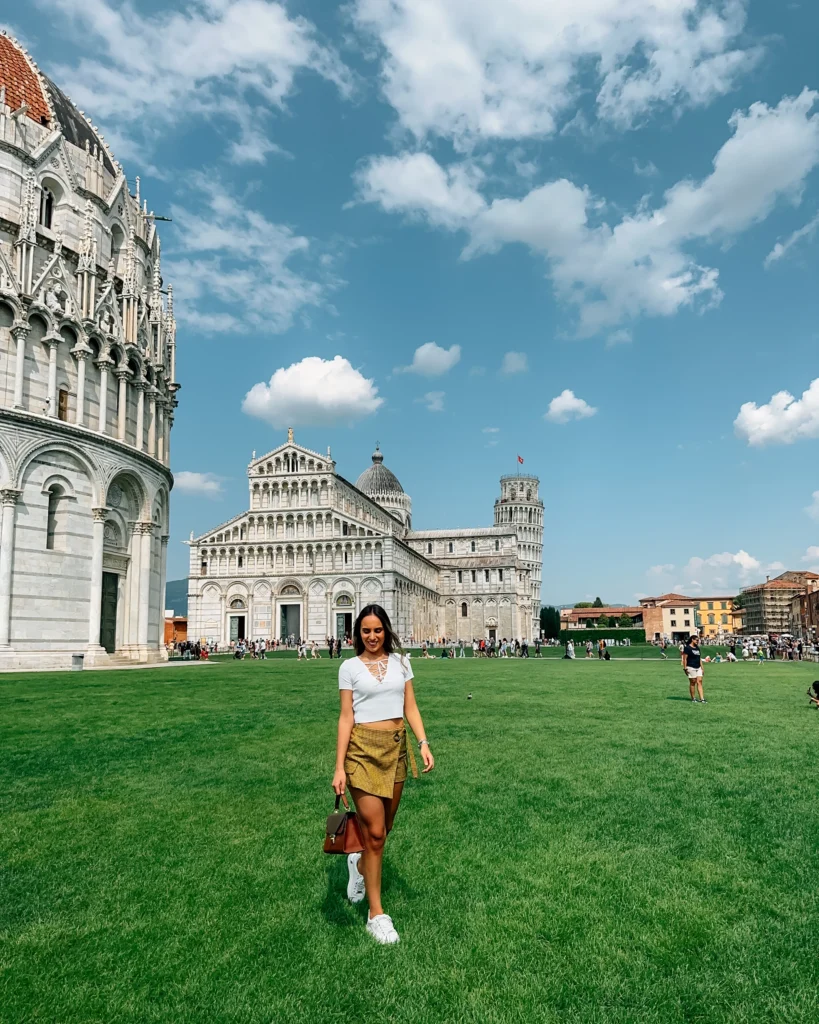
Palazzo dei Cavalieri and Piazza dei Cavalieri: After a photo session and a relaxing break on the grass at Piazza dei Miracoli, we headed towards Palazzo dei Cavalieri and Piazza dei Cavalieri. Piazza dei Cavalieri is one of the most important squares in Pisa and was the center of political power during the medieval period. The square was redesigned in the 16th century by the famous architect Giorgio Vasari under the command of Cosimo I de Medici, the Grand Duke of Tuscany, to become the headquarters of the Order of the Knights of St. Stephen.
Palazzo della Carovana: In the center of the square stands Palazzo della Carovana, an impressive palace built between 1562 and 1564 by Giorgio Vasari. The building served as the headquarters for the Knights of St. Stephen, a military and religious order founded by Cosimo I de Medici. The facade of the palace is decorated with elaborate frescoes, coats of arms, and allegorical figures. Today, it houses the Scuola Normale Superiore di Pisa, one of the most prestigious higher education institutions in Italy.
Statue of Cosimo I de Medici: In front of Palazzo della Carovana stands the statue of Cosimo I de Medici, created by sculptor Pietro Francavilla in 1596. The statue presents Cosimo I in an imposing posture, reflecting his power and influence over the city and the Tuscany region. Cosimo I was a remarkable leader who consolidated the power of the Medici family and significantly contributed to the artistic and cultural development of Tuscany.
Piazza dei Cavalieri is a place full of history and elegance, where every building and monument has a story to tell. Visiting this square offers a fascinating glimpse into the glorious past of Pisa and the Medici family.
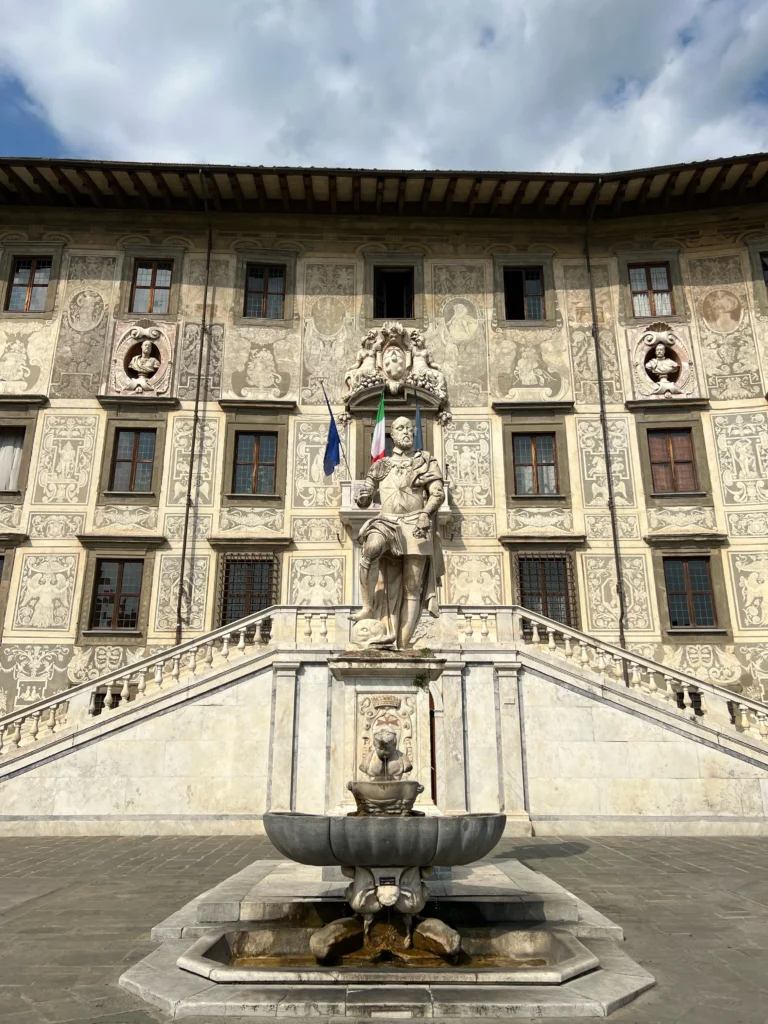
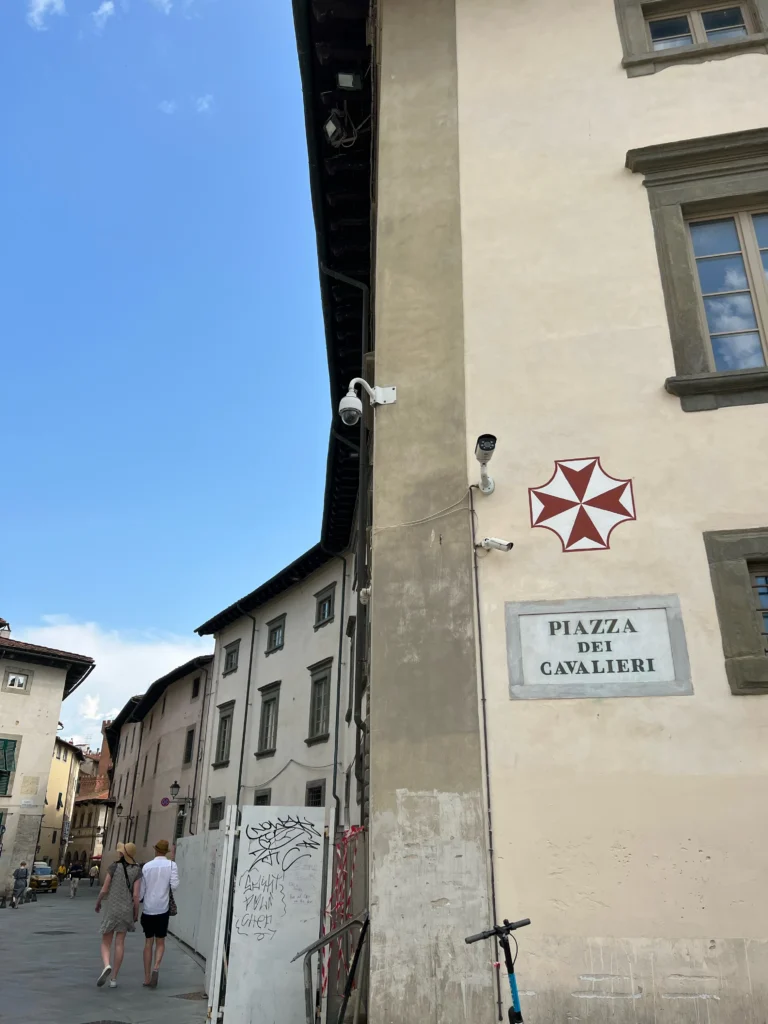
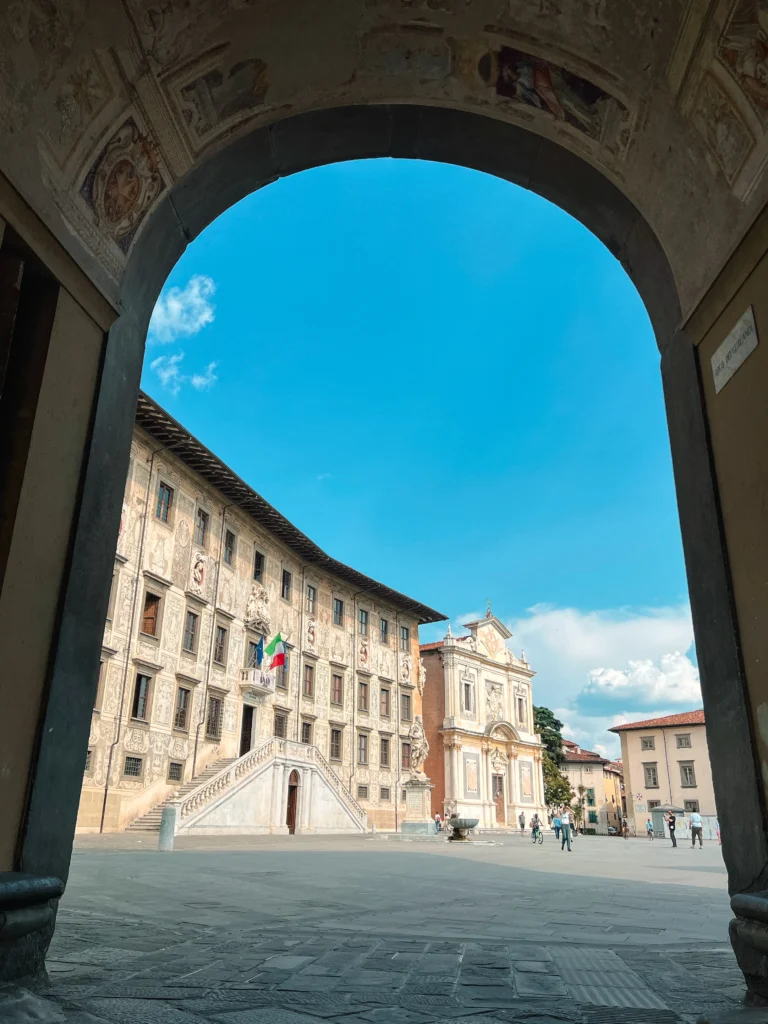
Primo Pasta and Street Food: To recharge our energy, we stopped at Primo Pasta and Street Food, where we enjoyed delicious dishes in a relaxed atmosphere. This spot is renowned for its authentic Italian cuisine, using fresh and high-quality ingredients. Homemade pasta and rich sauces reflect Tuscany’s culinary tradition, providing a true gastronomic experience.
Keith Haring’s Wall “Tuttomondo”: After lunch, we visited Keith Haring’s painted wall, a vibrant and colorful artwork that adds a touch of modernity to the city. Created in 1989, this is the famous American artist’s last public work, symbolizing peace and harmony. His distinctive murals, with outlined figures in black and bright colors, have become a significant cultural attraction in Pisa.
Arno River and Ponte Di Mezzo: On our way to Pisa Centrale station, we passed by the Arno River and crossed Ponte Di Mezzo, admiring the picturesque landscapes of the city. The Arno, Tuscany’s third longest river, plays a crucial role in the region’s history and development. Ponte di Mezzo, one of Pisa’s most important bridges, offers an ideal spot to enjoy the city’s panorama and observe local life. The current bridge was rebuilt after World War II and serves as a symbolic link between the city’s historic banks, bridging the past and the present.
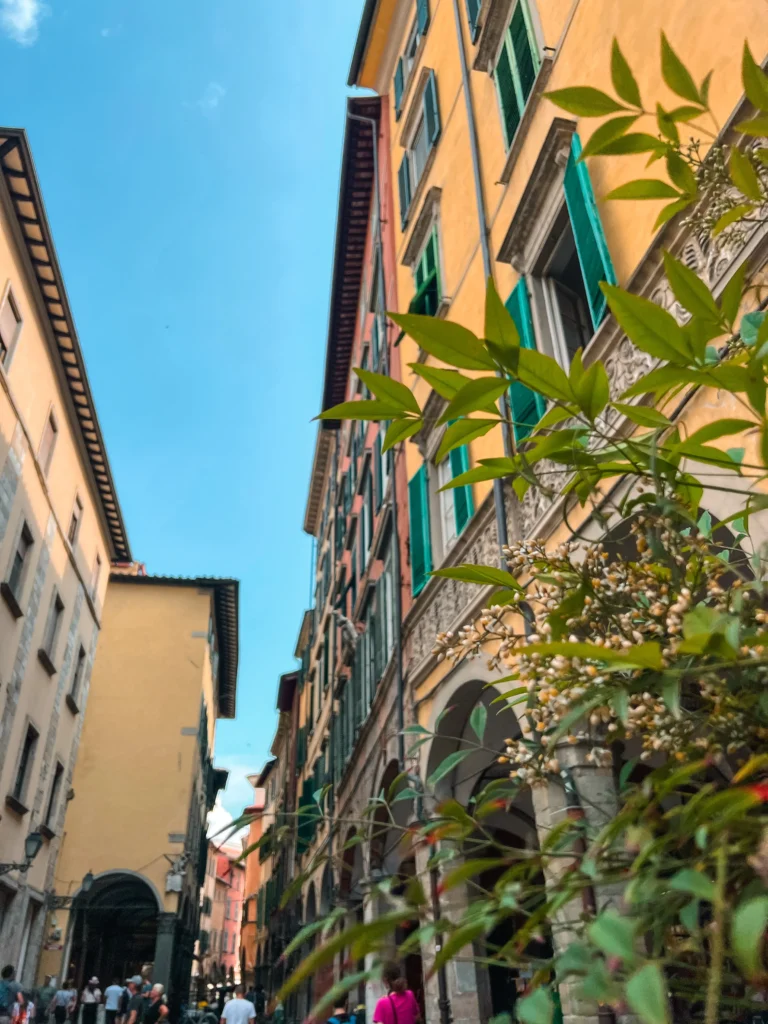
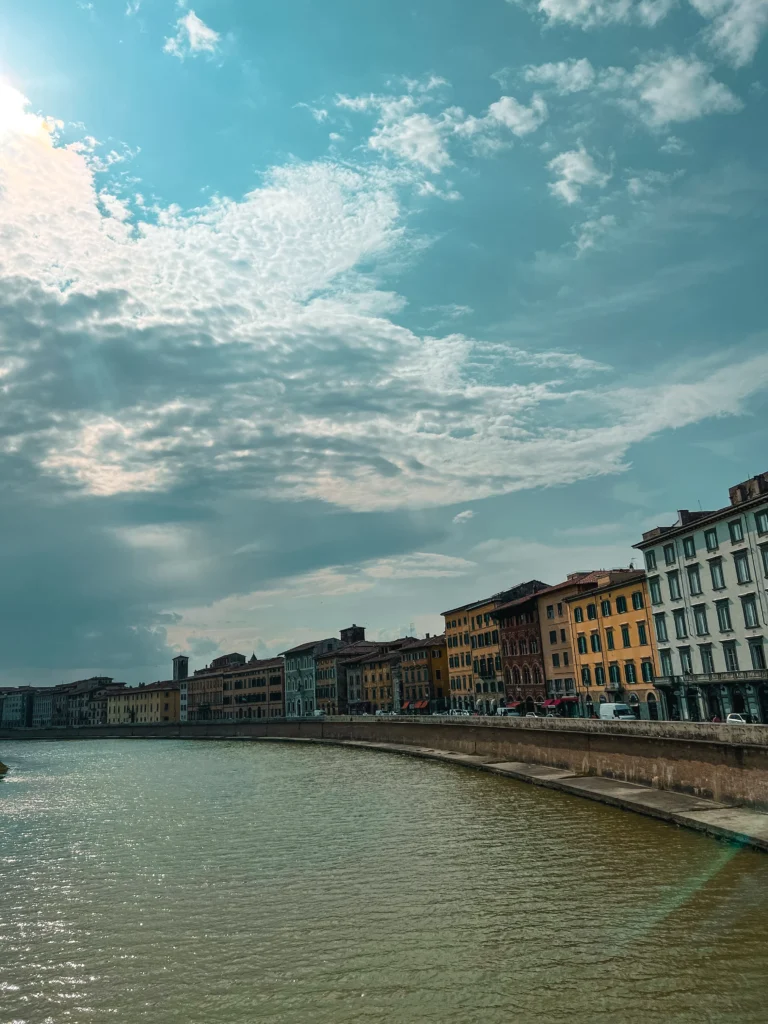
Trains in Pisa: Pisa Centrale Station is a crucial transportation hub, offering railway connections to numerous destinations across Italy. The trains are frequent and varied, including regional, intercity, and high-speed trains. From Pisa Centrale Station, we took the train to La Spezia Migliarina, paying around 8 euros per person. The journey was comfortable and fast, allowing us to enjoy the beautiful landscapes of Tuscany and Liguria.
That was our day in Pisa. I believe one day is sufficient to explore the city’s main tourist attractions, making Pisa an ideal destination for a quick stopover.
Recommended Restaurants in Pisa
- Osteria dei Santi: Located in the historic center of the city, this traditional osteria offers a delightful selection of authentic Tuscan dishes. The welcoming atmosphere and rich menu featuring fresh pasta, bruschette, and meat dishes will delight your taste buds.
- Ristorante La Grotta: Known for its romantic atmosphere and refined Italian cuisine, La Grotta is perfect for a special dinner in Pisa. Here you’ll find a variety of homemade pastas, fresh seafood, and selections of local wines.
- Dal Mozza Gourmet: Specializing in modern Tuscan cuisine, Dal Mozza Gourmet is renowned for its creative dishes and artistic presentation. It’s an excellent choice for those looking to experience new flavors in a contemporary setting.
- Primo Pasta and Street Food: Perfect for a quick and tasty meal while exploring the city, Primo Pasta and Street Food offers a variety of pastas and paninis prepared quickly with fresh ingredients. It’s ideal for a quick break during your visit.
These restaurants are excellent choices to savor local gastronomy and experience the authentic atmosphere of Pisa. Be sure to make reservations in advance, especially during peak tourist seasons, to fully enjoy the culinary experience in the city.
When to Visit Pisa?
The ideal time to visit Pisa depends on your preferences for weather and tourist crowds. Generally, the best months to travel to Pisa are:
Spring and Autumn: March to May and September to November. These months offer pleasant temperatures and clear skies, perfect for exploring the city and its attractions. The climate is moderate without extreme temperatures, making strolls through medieval squares and visits to the Leaning Tower more enjoyable.
Summer: June to August. Summer brings higher temperatures, especially in July and August. Days are long and sunny, ideal for enjoying walks along the Arno River and outdoor activities. This season is also the busiest, so it’s advisable to book accommodation and tickets to attractions in advance.
Winter: December to February. Winter in Pisa is mild and damp, with lower average temperatures and more rainfall. However, the city remains an attractive destination during this season due to its quieter atmosphere and fewer tourist crowds. Additionally, accommodation and tourist activity prices may be more affordable.
Choosing the right time to visit Pisa depends on your personal preferences and the type of experience you wish to have in this historic city in Italy.
Flight
To reach Pisa, you can choose to fly with various airlines operating on the Bucharest – Pisa route, such as Ryanair or WizzAir, with direct flights lasting approximately 2 hours and 30 minutes. Platforms like Skyscanner offer a wide range of flight options from anywhere in the world, providing you with the flexibility to choose the best options for your journey. Pisa’s Galileo Galilei Airport is well-connected to the city center, facilitating quick and convenient transfers.
Accommodation
To fully enjoy our experience in Pisa and Cinque Terre, we chose to initially stay in La Spezia after visiting the city of Pisa. Upon landing at Pisa Airport, we took advantage of a few hours to visit the famous Piazza dei Miracoli in Pisa, where we admired the Leaning Tower and other impressive monuments. Afterward, we headed to La Spezia to establish our base for further exploration of Cinque Terre. We opted for Welcome Migliarina, where we stayed for 4 nights. The apartment provided us with quick access (approximately 1km) to La Spezia Migliarina train station, from where we departed each day to explore Cinque Terre. We appreciated the comfort and tranquility offered by our apartment after full days of adventure in Cinque Terre and Pisa.Entry Requirements for Italy: European and Non-European Citizens
European Citizens:- Entry is free: European Union citizens can enter Italy with a valid ID card or passport. No visa is required.
- Identity document: Make sure you have a valid identity document throughout your stay in Italy. Health: No medical visa is required to enter Italy. However, it is recommended to have valid travel medical insurance.
- Visa requirements: Citizens of non-EU countries need a visa to enter Italy. Visa requirements may vary depending on the country of citizenship. Check the website of the Italian Embassy in your country for updated information.
- Identity document: Make sure you have a valid passport with at least 3 months validity beyond the planned date of departure from Italy.
- Return ticket: You may be required to show a return ticket or proof of sufficient means to leave Italy.
- Accommodation: You may be required to show proof of accommodation reservation for the duration of your stay in Italy.
- Sufficient funds: You may be required to show proof of sufficient funds to cover your expenses during your stay in Italy.
How to Get from Pisa International Airport to the City Center
Pisa International Airport (PSA) is located approximately 1 km northwest of the city center of Pisa, easily accessible with several transportation options. Choose the option that best suits your travel needs and budget:
- Bus:
Pisa Mover: Offers quick connections between the airport and Pisa Central Station (Stazione Centrale) in about 5 minutes.
Local bus lines: Connections available to various destinations within the city and surrounding regions. - Taxi:
Availability: Taxis are regularly available outside the arrivals terminal.
Travel time: Approximately 10-15 minutes depending on traffic.
Cost: The average price for a trip to the city center is around 10-15 €. - Uber/Cabify:
Ride-hailing alternative services: Available for app-based orders.
Order: Download the app, request a ride, and track its arrival.
Travel time: Similar to a taxi, with possible variations depending on demand. - Rental Car:
Car rental services: Available at the arrivals terminal.
Reservation: It is recommended to book in advance to ensure availability of the desired vehicle.
Route: Approximately 10-15 minutes to the city center, depending on traffic. - Public Transport:
Train travel: Option to take a train from Pisa Aeroporto to Pisa Centrale to reach the city center.
Tickets: Available at the self-service ticket machines in the station.
Additionally, you can easily and quickly reach the city center of Pisa on foot. This was our preferred option, allowing us to explore the city at a relaxed pace and admire its architectural beauty.
Furthermore, to make our visit easier, we left our luggage in a locker available at Pisa Central Station before starting our city exploration. This allowed us to enjoy our walks without being burdened by baggage, retrieving them later before heading to our accommodation in La Spezia.
Typically, prices for renting a locker at Pisa Central Station are around 4-6 euros for a full day, depending on the locker size and duration of use. Exact prices may vary slightly depending on the station’s specific policy and the size of the locker you choose.
These options provide the flexibility needed to organize your trip comfortably and efficiently in Pisa and the surrounding region.
Currency and Exchange in Italy
The official currency in Italy is the euro (EUR), and exchanging currency can be easily done at airports, banks, and currency exchange offices. Payments with cards are widely accepted in shops, restaurants, and cafes. During our travels, we primarily used Revolut cards for convenience and accessibility.
Transportation in Pisa
Walking: Pisa is a compact city, and many visitors prefer to explore its main attractions on foot. This was also our choice, allowing us to quickly reach the major points of interest.
Bicycles: Another popular option for getting around Pisa is renting bicycles, offering flexibility and quick access to various locations in the city.
Luggage lockers: For convenience, we used the lockers available at Pisa Central Station to securely store our luggage while exploring the city. This allowed us to explore without the burden of baggage and retrieve them later before heading to our accommodation in La Spezia.
These pieces of information will help you plan and enjoy your visit to Pisa, making the journey as pleasant and efficient as possible.
Food
Pisa, a city rich in history and Italian charm, will delight you not only with its impressive monuments but also with its rich and delicious local cuisine. Prepare to explore a variety of authentic flavors and culinary traditions that will tantalize your taste buds.
- Pizza: The famous Italian pizza, with its crispy crust and delicious toppings, is a must-try in Pisa. From simple Margherita to pizza with prosciutto and arugula, you’ll find various options throughout the city.
- Pasta: Italian pasta is another cornerstone of local cuisine. Whether you choose spaghetti al pesto, tagliatelle al ragu, or risotto with seafood, you’ll be immersed in the Italian art of pasta dishes.
- Gelato: Don’t miss out on Italian gelato, a creamy and refreshing dessert available in a wide range of flavors. A stroll through the streets of Pisa is incomplete without stopping to savor artisanal gelato.
- Antipasti: Start your meal with a selection of antipasti, such as bruschetta with fresh tomatoes and olive oil, or local cheeses and cured meats.
- Italian wines: Italy is famous for its excellent wines. Experience Chianti from the Tuscany region or Prosecco from northern Italy to complement your culinary experience in Pisa.
Recommendations for an authentic culinary experience:
- Visit traditional trattorias and osterias to taste authentic Tuscan dishes.
- Participate in guided food tours to learn more about the history and gastronomic culture of the region.
- Be curious and adventurous in trying new dishes and discovering the unique flavors of Italian cuisine.
Pisa invites you to explore its culinary richness and enjoy every flavor in a historic and picturesque setting, complemented by warm and welcoming Italian hospitality.
Conclusion
This detailed itinerary will provide you with a captivating experience in Pisa, exploring the city’s historical, gastronomic, and cultural attractions. The day is meticulously planned to ensure you make the most of your time in this iconic city in Italy. Please note that the costs mentioned in the guide may vary depending on the tourist season and the accommodation and activities chosen. It is recommended to check for updates and prepare for any necessary adjustments. Enjoy the vibrant exploration and discovery of Pisa, a city full of charm and history!
Did you know…
By purchasing through my links, you support me at no additional cost to you. Thank you for your support. ♥️

